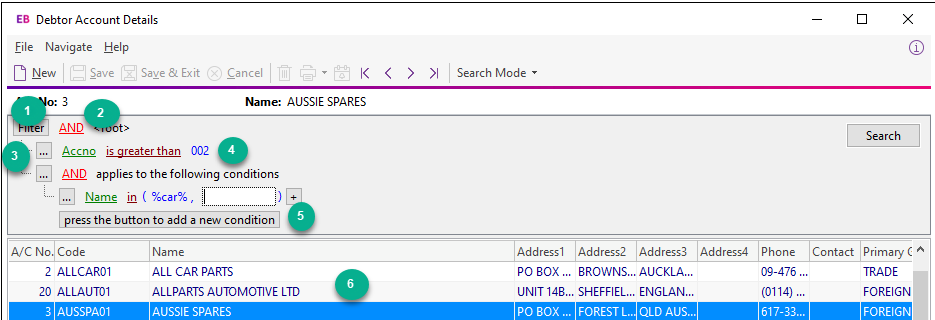Searching
Search windows follow a common style, regardless of what you're searching for.

-
To narrow the search, enter part of the name in the Search Key. You can enter other details (such as the account number or the Alphacode in an account search) into the Search Key field. You can search on:
-
Account number, Code and Name
-
Any part of the debtor address
-
Phone number
-
Contact name
-
Balance
Note: You cannot search by Primary Group.
-
-
Select the options for the search. For example, Extended search searches more fields (such as address, or extra search fields), however it is slower. If Extended search is not selected, only basic fields are searched such as the account name and number. Select the Include inactive accounts option to include both active and inactive accounts in your search.
-
Click Search.
-
To select an item and view more detail, use the Up and Down arrow keys and press Enter, or double click on the item.
When inside a transaction entry grid, and you need to find an item such as an account or stock item needs, enter a question mark ? and press Tab to return all the items in a search list. You can perform a partial search by entering part of a term — for example, enter FISH and press Tab to return all items starting with FISH.
Advanced Search
The advanced search feature is available on several windows. You might need to access it by selecting Advanced Search from the Search Mode control or from the File menu.
Note: It will take some experimentation before you are familiar with advanced search. If you have a large customer base, familiarise yourself with this tool.

-
To begin configuring the search parameters, click the Filter button to add a condition or a group, or click press the button to add a new condition. You can click the Filter button to clear all the search parameters from its popup menu.
-
The red items are boolean functions. Use the AND operator between terms retrieves documents containing both terms. OR retrieves documents containing either term. NOT excludes terms from your search. Click on this to choose the function from the popup menu.
-
Click the ellipsis button to add a condition, add a group, or remove a row.
-
The green, maroon, and blue text items define the search parameter. The green and maroon items are interactive and open a popup menu when clicked. The green item is the field definition, the maroon item is a conditional argument, and the blue text is a user-defined variable. You can compare the blue text to the Search Key field in the standard search window.
Note: When using the like argument, the percent character (%) is a wildcard. For example, to search for all Debtors whose names begin with A, enter Name like A%.
-
Add additional filter criteria by clicking the button at the bottom of list.
-
The search result displays below.
Adding Search Fields
You can use profile settings to add fields to search windows with the Extra ... search fields profile settings in Exo Business Configurator — for example, Extra creditor account search fields, Extra stock items search fields, Extra debtor account transactions search fields, and the like. To add extra search fields, enter text into these settings in the format Field=Caption=SearchBehaviour=Format, where:
- Field is the name of the database field to add.
- Caption is the name to appear for the field on the search window.
- SearchBehaviour is a string of characters that determines how to search on the field:
-
- G = show this field as an optional visible column in the search grid.
- S = add this field as part of the select statement.
- W = make this field value a condition in the WHERE clause.
- U = force a character to uppercase for comparison. (String Fields)
- E = use Exact match (=) in the where clause rather than LIKE. (String Fields)
- Format determines how the field should be formatted:
-
- Cost = Use standard cost price formatting, without a currency symbol.
- Sell = Use standard sell price formatting, without a currency symbol.
- Balance = Use standard balance formatting (2 decimal places), without a currency symbol.
- Qty = Use standard quantity formatting.
- Disc = Use standard discount formatting, with a percent symbol (%).
- DateTime = Show date/time as dd.MM.yyyy hh:mm:ss.
- Date = Show date as dd.MM.yyyy.
- BillQty = Use standard bill quantity formatting.
- BillCost = Use standard bill cost formatting.
- a number between 0 and 15 = Use the specified number of decimal places — for example, 3 will give 123.450.
You can specify multiple search fields, separated by commas.
The =Caption, =SearchBehaviour, and =Format values are optional. If no =SearchBehaviour option is specified, the default behaviour is GSWU. If no =Format parameter is specified, formatting is applied to the field based on its field name and display name. If the display name or field name contains:
- COST - Use standard cost price formatting, without a currency symbol
- SELL or PRICE - Use standard sell price formatting, without a currency symbol
- BAL - Use standard balance formatting (two decimal places), without a currency symbol
- QTY or QUANTITY - Use standard quantity formatting
- DISC - Use standard discount formatting with a percent symbol (%)
For example, entering "FAX=Fax Number, EMAIL=Email Address" into the Extra debtor account transactions search fields setting adds fields for fax number and email address to the Debtor search window.
Note: Extra search fields added to search windows are searched on when Extended search is selected. You can select them when building a query on the advanced search interface.
